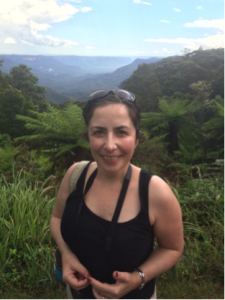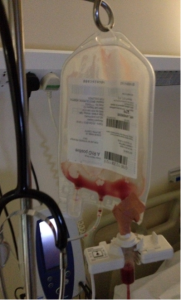There are lots of different types of cancer and, increasingly, just as many different types of treatments. While many people with ‘solid’ tumours receive surgery, radiotherapy and chemotherapy, blood cancers sometimes require a slightly different tack. In our new blog, Helen shares her experience with a stem cell transplant for Hodgkin lymphoma and discusses how her vocabulary – as well as her health – have changed over the last few years. We’d love to know what you think about the blog so please get in touch by leaving a comment or tweeting us on @shinecancersupport.
Let’s just say that science wasn’t my strong point at school. Now I wish that I could go back to my biology teachers and confuse them with the words like ‘chimerism’ that are now part of my regular language. For all its unpleasantness, having a donor stem cell transplant at the age of 33 has given me more than just a wider vocabulary.
In September 2010, I had just got married, celebrated my 30th birthday and moved to beautiful Gloucestershire, ready to start a new life with my husband. I had been a primary school teacher in London and was keen to find a new job in the countryside. A few short months later, I was diagnosed with Hodgkin’s lymphoma and any ideas of an idyllic life were put on hold.
I had ABVD chemotherapy and radiotherapy and achieved remission. However, months later, the cancer returned. I had to have more intensive chemotherapy and was told that I would need a stem cell transplant.
I had heard of bone marrow transplants but wasn’t sure how they differed from stem cell transplants. It turns out that the process is the same; the only difference is where in the body the cells are taken from. I knew something about how transplants work; high dose chemotherapy is given to kill off immunity, then replaced by new stem cells in order to create a disease-free immune system. However, at this stage I did not know that there are two types of transplant – one that uses healthy stem cells ‘harvested’ from your own body (autologous) and one that uses stem cells from a donor (allogeneic). Because I hadn’t responded as hoped to the second round of chemotherapy, the decision was made for me to have a donor transplant.
To be a donor, someone must have a ‘matching’ tissue type. My sister was tested, but was not a match. My only hope was to rely on the worldwide database of people who are willing to donate their stem cells should someone need them. So here’s to my match – an anonymous man from Germany who selflessly donated his stem cells to me, a complete stranger in England! If he hadn’t signed up to the register, who knows where I would be now?
Once I learned more about what it involved, my mind was full of questions. How long would I be in hospital for? With no immune system I would have to stay in isolation; how would I cope? How long would it be before I could go back to work? How would we manage financially? Would I get Graft versus Host Disease (which is where the new cells are recognised as ‘foreign’ and rejected by the body)?
Realising that I would be spending a long time in my hospital room, I decided to make it feel as homely as possible. I decorated the walls with photos and inspiring quotations (laminated, of course, so that they could be cleaned every day!). Instead of the hospital pillow cases the nurses let me bring my own from home as long as they were changed daily. I brought in a selection of DVDs, a laptop loaded with games, plenty of books to read and my adult colouring books, which I find helpful to relieve stress.
Some days, the most that I could achieve was to have a shower, but I made sure that I did this every day as it helped me to stay motivated. I also read about and practised mindfulness techniques which I found invaluable for dealing with all that was happening. Fortunately the hospital I was in had Wifi, which meant that I could stay in touch with family and friends over Skype.
My new stem cells were given to me on 9th October 2013. I remember seeing them arrive by courier in a yellow bag and thinking that someone in the hospital was getting a pizza delivered! The process of receiving the cells was a bit of an anti-climax. It took around 40 minutes and was just like having a blood transfusion; the bag of blood cells was infused through my central line. The day that a transplant patient receives a new immune system is often seen as a new ‘birthday’. Apart from transplant patients only one other person has two birthdays a year and that’s the Queen!
After five and a half weeks, I left hospital. I still had to go for check-ups every week, partly so that the doctors could check on my ‘chimerism’. This refers to the percentage of donor cells in the blood and it is desirable after a transplant to be as close to 100% donor as possible. Although when I left hospital, my chimerism was good, by February 2014 it had gone down and I needed a ‘top up’ of my stem cells. This required an overnight stay in hospital but my chimerism has been going up ever since.
As soon as I was able, I went back to work in a Further Education college, a job I had started after my first remission. It was a change from my previous job but I enjoyed it. I visited Berlin, Spain, Hong Kong and Australia, all within the first year after leaving hospital. Almost a year and a half after my transplant I am having further treatment as some lymphoma has been found again in my body. However, because I have had a donor stem cell transplant, I can have another ‘top up’ of my new cells which, it is hoped, will get rid of the cancer for good.
I thought that moving to a different part of the country would make things harder to deal with, but it has actually helped me physically and emotionally because I could explore new places when I was well enough times during my treatments. Having so many changes in a short space of time showed me that I am adaptable and whenever I feel angry at having had to go through a stem cell transplant, I think of some of the things that I have been able to enjoy because of it: becoming a regular practitioner of mindfulness, going to four different countries in one year, having two birthdays and enjoying a new career path to name but a few!
Helen is a former primary school teacher now working as a Learning Support Assistant in a college of Further Education. She lives in Gloucestershire with her husband and Eric the cat.
You can register to donate your stem cells via Anthony Nolan, a charity devoted to saving the lives of people with blood cancer.


